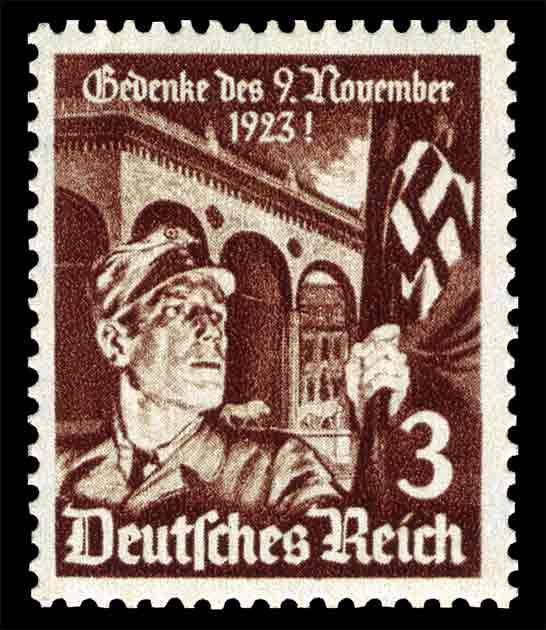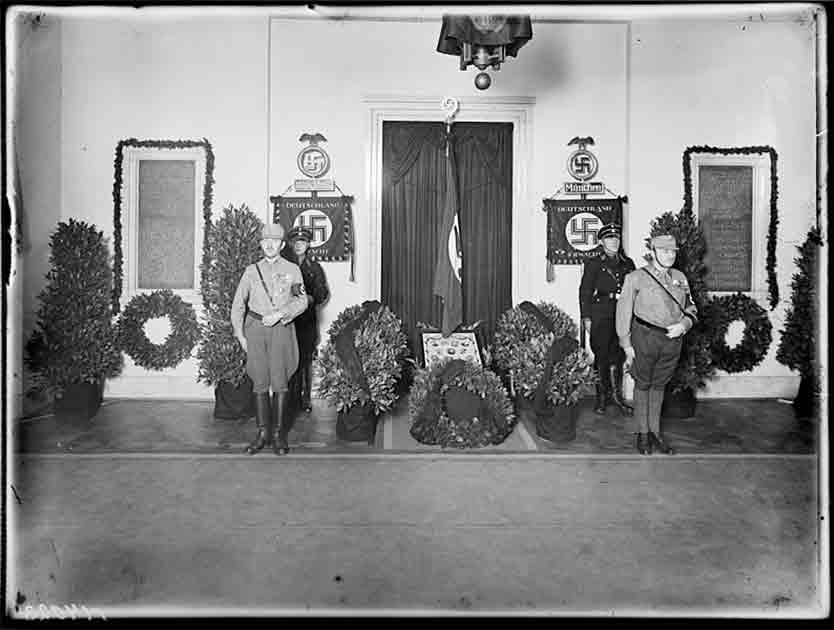When it comes to Nazi Germany few artifacts held as much mystique or significance as the Blutfahne, or Blood Flag. This terrible emblem of Nazi sacrifice and martyrdom, stained with the blood of fallen comrades during the Beer Hall Putsch of 1923, became a rallying point for Hitler’s burgeoning movement in the 1920s and 1930s.
Yet, its fate remains shrouded in mystery. Vanishing amidst the chaos of World War II’s aftermath, the Blutfahne’s disappearance has sparked speculation and intrigue for decades.
Was the Blutfahne spirited out of the falling Reich by escaping Nazis? Was it destroyed or taken as a trophy?
And could it still survive?
The Blutfahne and the Beer Hall Putsch
To understand the Blutfahne’s importance to the Nazis, particularly Hitler, one has to look all the way back to the evening of 8 November 1923. On this chilly winter night, a relatively unknown politician belonging to a fringe German political party marched into a beer hall in Munich and changed history forever.
The party was the Nationalsozialistische Deutsche Arbeiterpartei, aka the Nazi party. It’s easy to guess who the politician was.

Before that night, the Nazi party was relatively small and not particularly influential. Hitler himself had built a small following by acting as the party’s speaker and propagandist and had won favor with some nationalists and anti-Semitic groups but no one was taking either him or his party that seriously.
However, that night the Sturmabteilung, the Nazi party’s paramilitary troops melodramatically named the “stormtroopers”, surrounded the Bürgerbräukeller beer hall in Munich, in Bavaria in southeastern Germany. Inside, State Commissioner Gustav Ritter von Kahr was speaking in front of an audience of 3000 people. Before he could finish his speech Hitler stormed in and announced his presence by firing his gun into the ceiling.
He proclaimed, “The national revolution has broken out! The hall is surrounded by six hundred men. Nobody is allowed to leave.” According to Hitler, the Bavarian government was no more and had been replaced by a new one led by General Ludendorff, a hero of World War One.
The following day two thousand of Hitler’s followers marched through the streets of Munich towards Feldhernhalle, the Bavarian Defense Ministry. Hitler believed that by placing Ludendorff at the head of a new government, Germany would regain the status she had lost after her defeat in WW1.
But it seems Hitler’s announcement may have been a bit premature. Upon arriving at the Feldhernhalle the Nazi thugs were greeted by 130 Bavarian soldiers and a number of armed police officers. Inevitably the two sides opened fire on one another and men from both sides were wounded and killed.
Four police officers and 16 Nazis were killed. One of the men hit, Heinrich Trambauer, happened to be carrying the company flag of the 5th Munich SA, a flag bearing the Nazi swastika symbol.
Upon being hit he dropped the flag. At the same moment the man marching alongside him, Andreas Bauriedl, was killed, falling on the flag. Now soaked in the blood of at least one “martyr” the flag was transformed into the Blutfahne, or Blood Flag.
What happened next is a little unclear. Hitler managed to escape the bloodbath but was later arrested and tried for high treason. He was found guilty and sentenced to five years in Landsberg Prison but served only 9 months. During this time he wrote Mein Kampf.
In regard to the newly born Blutfahne, there are two stories. The first tells that a wounded Trambauer managed to rescue that flag, hiding it inside his jacket and then giving it to a friend, Karl Eggers, to hide. The second story says that the Munich police confiscated the flag at the scene but later returned it, handing it over to Eggers.
It’s unclear which story is true, although the Nazi party later preferred the first story, most likely because it was more romantic. Either way, both stories end the same way. Upon Hitler’s early release from prison Eggers handed over the flag to the Nazi’s new golden boy.
A Nazi Icon
Hitler may have been a monster, but he knew the power of symbolism and made sure the Blutfahne didn’t go to waste. He had the Blutfahne mounted to a fresh staff and finial (the knob at the end of a flagpole).
Just below the finial was a silver plaque with the names of the 16 Nazi “martyrs” engraved on it. No longer just a flag, the Blutfahne was now a symbol of Nazi sacrifices and martyrdom.

In 1926, during the second Nazi party congress at Weimar Hitler presented Joseph Berchtold, the head of the SS, with the flag. It was a major honor.
Following this, the flag was seen as nothing short of sacred by the Nazi party. It was given its own attendant, SS Sturmbannführer Jakob Grimminger, who was tasked with presenting it at countless party rallies and meetings.
At his annual Nuremberg rallies, Hitler would anoint the other Nazi banners and flags by touching them with the Blutfahne, sanctifying them. This bit of pageantry even had its own name, the flag consecration or “Fahnenweihe.” The flag was also used during ceremonies to seal the blood oath of the party’s newly conscripted SS men.
- Was the Mystical French Oriflamme Undefeatable?
- Panzer IX & Panzer X: The Nazi Terror Tanks and the Art of Deception
When not being used for these kinds of rituals the Blutfahne was kept at the Brown House, the Nazi’s HQ in Munich where it had its own SS guard of honor. The flag was kept in immaculate condition, the only damage being a small tear, thought to have been done during the Beer Hall Putsch. A reminder of the flag’s history, this tear was never repaired.
The flag remained more or less in public view throughout the 1930s and into WW2. The flag was last seen in public on 18 October 1944 at the Volksstrum induction ceremony (the Volksstrum being a civilian militia established by the Nazis towards the end of the war).
The ceremony was led by Hitler’s right hand, Heinrich Himmler, and attended by several high-profile Nazis. What happened to the flag after the ceremony is a mystery, it was never seen in public again.
There are a handful of theories, however. The most popular, and likely, answer is that it was taken back to HQ and destroyed during the Allied bombing of Munich in 1945. Just as the Nazis themselves were destroyed, so was their most revered symbol.
Another popular theory is that the Blutfahne was taken as a souvenir by Allied forces after they swept into Munich. Already damaged by the bombing, it could have been split into fragments and its pieces taken home by a number of US infantrymen.
Or one unwitting soldier could have stumbled upon it, and not realizing what he had found, taken it home. If true this means the ultimate Nazi treasure could be sitting in an attic in the United States, waiting to be discovered.

If this theory is correct, considering the disturbing value of Nazi memorabilia, and the alt-rights resurgence in recent years, one can only hope the right person finds it. Perhaps it is best destroyed.
But, whatever its ultimate fate, the Blutfahne remains a poignant emblem of the dark chapter of Nazi Germany. Its disappearance, shrouded in mystery, only adds to its enigmatic legacy. Whether destroyed, hidden, or lost to the sands of time, the Blood Flag continues to fascinate and haunt the collective consciousness.
Yet, beyond its physical absence, its symbolic power endures, serving as a chilling reminder of the depths of human depravity and the enduring importance of vigilance against tyranny. As we reflect on its elusive fate, may the lessons of the Blutfahne inspire vigilance against the resurgence of hate and oppression.
Top Image: Hitler, accompanied in his car by the Blutfahne, salutes Nazi stormtroopers during a 1935 parade. Source: Robert Sennecke, Internationaler Illustrations-Verlag Berlin SW 11 (Image file marked as Public domain in Narodowe Archiwum Cyfrowe) / CC BY-SA 4.0.